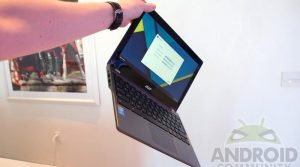As we get started with a new school year, teachers in classrooms across the district are dealing with a few dozen factors every class period that cause them anxiety. One of them is the mere act of signing out and opening up the Chromebook cart. But it doesn’t have to feel like a gamble every time students use technology. I thought I’d offer a few practical tips to help the use of Chromebooks in your classroom go more smoothly, à la a pitifully forced Kenny Rogers The Gambler theme…
You’ve got to know how to hold ’em. (Know when to fold ’em.)
Ok, this may seem a little obvious, but a simple, quick lesson and frequent reminders will help prevent one of the biggest causes of Chromebook damages: dropping. Enforce the two-hands policy in every grade.
 In most cases, I would also ask students to carry them closed. This makes them far more stable to carry, and prevents the temptation to just pick the Chromebook up by the screen. It doesn’t take long to start them back up. I can’t tell you how many times I’ve seen students carrying open Chromebooks on top of a pile of books across the classroom or with one hand at their side with the keyboard hanging down.
In most cases, I would also ask students to carry them closed. This makes them far more stable to carry, and prevents the temptation to just pick the Chromebook up by the screen. It doesn’t take long to start them back up. I can’t tell you how many times I’ve seen students carrying open Chromebooks on top of a pile of books across the classroom or with one hand at their side with the keyboard hanging down.
Ok, I’ll admit. That one was a stretch. But the next few are legit.
Give every student a Chromebook number that never, ever changes.
At the beginning of the semester, consider giving every student their own Chromebook number. Record the numbers on a spreadsheet or on your class roster. And vow to never ever change the number. This gives students a specific Chromebook that they are always responsible for no matter what cart. Let them know this is the Chromebook they are financially responsible for. And if it’s not in the cart when they go to get theirs, they’re still responsible for it, so they better find it before someone else damages it. This will prevent students from just grabbing whatever Chromebook is available and makes tracking down misuse easier later. It also helps to eliminate the annoying “It’s not mine, so who cares” mentality. Then, consider having a spreadsheet with the Chromebook numbers on it so you can record any issues with the Chromebook for reference later on.
Implement the 3-Minute Rule
This was a rule passed on to me by a veteran teacher in my first year in the tech lab. Here’s how it works: Give students 3 minutes to look over their Chromebooks and report any damages. Any damages that require a repair fee that are reported in the first 3 minutes are the responsibility of the student who used it immediately before. Let them know any damages reported after 3 minutes are their responsibility and they will be held responsible for them. This helps students to understand that they need to pay careful attention to the condition of the Chromebook and helps them understand their responsibility toward it. This also helps you to know when things need to be fixed and a helpdesk ticket needs to be filled out.
You (yes, YOU) fill out the help desk ticket.
As the responsible adult in the room, submit a help ticket whenever a student reports a damaged or non-working Chromebook. If you wait for someone else to do so, it may never be addressed and the workload will pile up for our already overworked techs. Don’t wait–submit it as soon as a student reports the issue. Then be sure to find a way to communicate this to the other teachers who use the same cart (like with a sheet on the top of the cart) so the ticket is not duplicated. The best way to maintain the Chromebooks is with diligent oversight of the machines.
A place for every Chromebook and every Chromebook in its place.
Make sure students return their Chromebooks to the slot that corresponds with the number of their Chromebooks (if this is not done for your cart, it’s a good idea to make it happen). This makes it easier for the next group to quickly find their Chromebook and get to work. It also helps to see if Chromebooks are missing, and which ones.
Know when to walk around.
When? The entire time. The best way to monitor student activity is to circulate the room. And it also puts you in a better position to facilitate learning. Programs that show you every student’s screen, while helpful at times, can stifle the learning community in the long run and can reinforce the perception that the technology is a babysitter. Stay engaged as the teacher.
Know when to run.
Never. Never ever run with Chromebooks. Sorry, had to finish it out. I know…
Got other tips for facilitating Chromebook use? We’d love to hear from you! Leave a comment below with other ideas for teachers.
